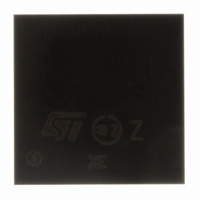STR755FR2H6 STMicroelectronics, STR755FR2H6 Datasheet - Page 8

STR755FR2H6
Manufacturer Part Number
STR755FR2H6
Description
MCU ARM7 32BIT 256K FLSH 64LFBGA
Manufacturer
STMicroelectronics
Series
STR7r
Datasheet
1.STR750FV0T6.pdf
(84 pages)
Specifications of STR755FR2H6
Core Processor
ARM7
Core Size
32-Bit
Speed
60MHz
Connectivity
I²C, SPI, SSI, SSP, UART/USART
Peripherals
DMA, PWM, WDT
Number Of I /o
38
Program Memory Size
256KB (256K x 8)
Program Memory Type
FLASH
Ram Size
16K x 8
Voltage - Supply (vcc/vdd)
3 V ~ 5.5 V
Data Converters
A/D 11x10b
Oscillator Type
Internal
Operating Temperature
-40°C ~ 85°C
Package / Case
64-LFBGA
For Use With
MCBSTR750UME - BOARD EVAL MCBSTR750 + ULINK-MEMCBSTR750U - BOARD EVAL MCBSTR750 + ULINK2497-5754 - KIT STARTER IAR STR750497-5753 - KIT STARTER KEIL FOR STR7/STR9497-5752 - KIT STARTER IAR FOR STR7/STR9497-5748 - BOARD EVALUATION FOR STR750XF
Lead Free Status / RoHS Status
Lead free / RoHS Compliant
Eeprom Size
-
Available stocks
Company
Part Number
Manufacturer
Quantity
Price
Company:
Part Number:
STR755FR2H6
Manufacturer:
STMicroelectronics
Quantity:
10 000
Introduction
8/84
periodic interrupt. It is clocked by an external 32.768 kHz oscillator or the internal low power
RC oscillator. The RC has a typical frequency of 300 kHz and can be calibrated.
WDG (watchdog timer)
The watchdog timer is based on a 16-bit downcounter and 8-bit prescaler. It can be used as
watchdog to reset the device when a problem occurs, or as free running timer for application
time out management.
Timebase timer (TB)
The timebase timer is based on a 16-bit auto-reload counter and not connected to the I/O
pins. It can be used for software triggering, or to implement the scheduler of a real-time
operating system.
Synchronizable standard timers (TIM2:0)
The three standard timers are based on a 16-bit auto-reload counter and feature up to 2
input captures and 2 output compares (for external triggering or time base / time out
management). They can work together with the PWM timer via the Timer Link feature for
synchronization or event chaining. In reset state, timer Alternate Function I/Os are
connected to the same
I/O ports in both 64-pin and 100-pin devices. To optimize timer functions in 64-pin devices,
timer Alternate Function I/Os can be connected, or “remapped”, to other I/O ports as
summarized in
a control register.
Table 3. Standard timer alternate function I/Os
Any of the standard timers can be used to generate PWM outputs. One timer (TIM0) is
mapped to a DMA channel.
Motor control PWM timer (PWM)
The Motor Control PWM Timer (PWM) can be seen as a three-phase PWM multiplexed on 6
channels. The 16-bit PWM generator has full modulation capability (0...100%), edge or
centre-aligned patterns and supports dead-time insertion. It has many features in common
with the standard TIM timers which has the same architecture and it can work together with
the TIM timers via the Timer Link feature for synchronization or event chaining.The PWM
timer is mapped to a DMA channel.
TIM 0
TIM 1
TIM 2
Standard timer functions
Input Capture
Output Compare/PWM
Input Capture
Output Compare/PWM
Input Capture
Output Compare/PWM
Table 3
and detailed in
Table
STR750Fxx STR751Fxx STR752Fxx STR755Fxx
package
100-pin
6. This remapping is done by the application via
2
2
2
2
2
2
Number of alternate function I/Os
Default mapping
1
1
1
1
2
1
64-pin package
Remapped
2
1
2
2
1
2


















